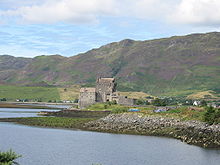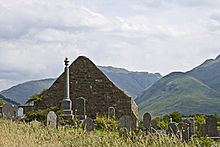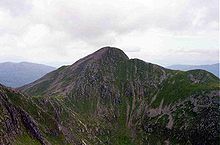- Clan Macrae
-
Clan Macrae Crest badge 
Crest: A cubit arm grasping a sword all Proper Motto: Fortitudine Slogan: Sgurr Uaran Profile Region Highland District Wester Ross Plant badge club moss Chief Clan Macrae has no chief, and is an armigerous clan 
Arms of the last Chief of Clan Macrae Last Chief: Macrae of Inverinate Historic seat Eilean Donan Allied clans Clan Mackenzie Rival clans Clan Ross The Clan Macrae is a Highland Scottish clan. The clan has no chief; it is therefore considered an Armigerous clan.
Contents
Surname
The surname Macrae (and its variations) is an Anglicisation of the patronymic from the Gaelic personal name Macraith. This personal name means "son of grace".[1] The name is recorded numerous times in the Middle Ages, and was used by various unrelated families.[2]
Traditional origins of the clan
According to the late 19th century historian Alexander Mackenzie, and Rev. Alexander Macrae in the early 20th century, the main authority for the early history of Clan Macrae is the late 17th century manuscript account of the clan written by Rev. John Macrae.[3][4] Alexander Macrae largely based his history of the clan upon John Macrae's earlier account.[5]
According to tradition, the Macraes were originally from Ireland, and shared a common ancestry with the Mackenzies and Macleans. The Macraes were said to have originated from Clunes, which is located near the southern shore of the Beauly Firth, and was within the lordship of Lovat. Alexander Macrae stated that these traditions likely refer to a period sometime in the middle of the 13th century.[6] According to John Macrae, after a violent dispute arose between the Macraes and more powerful Frasers of Lovat, three sons of the Macrae chief set off for new lands. One of the sons settled in Brahan, near Dingwall; another settled in Argyll; and the other settled in Kintail.[4]
At that time Kintail was held by the Mackenzies, and according to John Macrae's account, there were very few Mackenzies of the chiefly line and thus the chief of that clan welcomed the Macraes because they shared a common descent and could be relied upon. Although John Macrae did not know the name of the Macrae brother who settled in Kintail, he stated that this Macrae brother married the daughter, or granddaughter, of Macbeolan who possessed a large part of Kintail before the Mackenzie's rise to power.[note 1] Alexander Mackenzie considered this marriage to be the real reason for the loyalty given by the Macraes to their Mackenzie lords; he did not believe the Macraes and Mackenzies to share a common ancestry in the male line as John Macrae had claimed.[4]
Alexander Macrae was of the opinion that these events probably took place sometime in the first half of the 14th century, before the Mackenzies became firmly established in the Kintail area. He stated that there didn't appear to be any evidence that the Macraes were in the Kintail area before the time of these events, but noted that it was said that Eilean Donan Castle was garrisoned by Macraes and Maclennans in the late 13th century, during the period when the fortress was first taken into possession by Kenneth, founder of the Mackenzies of Kintail.[6]
According to tradition, one of the prominent ancestors of the Macraes from Kintail was Fionnla Dubh mac Gillechriosd, According to John Macrae, Fionnla Dubh mac Gillechriosd was about two, or three, generations removed from the Macrae who settled in Kintail from Clunes. Alexander Macrae stated that Fionnla Dubh was a contemporary of Murdo Mackenzie, fifth chief of the Mackenzies of Kintail. In 1416, Murdo died and was succeeded by his son, Alexander.[8] According to the traditions of John Macrae, when the bastard uncles of the young Mackenzie chief began oppressing the folk of the district, Fionnla Dubh was instrumental in retrieving him from the south of Scotland; upon Alexander's return, the Mackenzie lands were brought back under control. The main line of the Macraes from Kintail, the Macraes of Invernate, trace their descent from Fionnla Dubh.[8]
History
The Macraes are known to have been constant supporters of the Mackenzies in recorded times; in 1520, and for many years onwards, they were constables of Eilean Donan Castle.[9] In view of their constant service to the Mackenzies, the Macraes of Kintail became known as the Mackenzies' "shirt of mail".[4] Macraes also served as counsellors to the chiefs, tutors of the chiefs' sons, chamberlains of Kintail and ministers of the local churches. There were also poets, physicians and musicians among the Macraes.[citation needed]
17th century and civil war
The Rev. Farquhar Macrae, born in 1580, Constable of Eilean Donan, was both an energetic churchman and a great Latin scholar. On his first visit to the island of Lewis he is said to have baptised all the inhabitants under forty years of age, no clergyman having resided on the island during that period. His second son, John Macrae, became minister of Dingwall in 1640 and died in 1704,
During the Civil War the Clan Macrae supported the Royalistcause but under the equivocating Earl of Seaforth firstly fought valiantly on the losing State side at the Battle of Auldearn in May 1645 before following Seaforth to support the royalist James Graham, 1st Marquess of Montrose.
Rev. Farquhar Macrae's grandson, Duncan Macrae of Inverinate was the compiler of the famous Fernaig manuscript 1688-93.[10]
18th and Jacobite risings
The Jacobite Rebellion of 1715 was a disastrous event for the Macraes. The crucial battle was the Battle of Sheriffmuir, near Stirling. The Macraes formed the left flank and were left unprotected when the Jacobite cavalry was moved by error across to the right. The Highland foot (Macraes) were charged by the Government cavalry, fell back and rallied again and again, up to twelve times. Of the 663 Jacobite casualties suffered in the battle 58 of those killed were Macraes. Among those killed was Duncan Macrae, who as a young man was known for both his superior strength and his tender heart. During the battle he killed at least seven men with his claymore before he was shot down by an English trooper. His claymore was exhibited for many years in the Tower of London as "The great Highlander’s sword". Another Macrae killed at Sheriffmuir was John of Conchra, who was distinguished in battle and esteemed in the Highlands, he was one of the "Four Johns of Scotland".[citation needed]
In 1721 a force of men from the Clan Ross, led by chief William Ross 6th of the Pitcalnie line and his brother Robert went on a rent collecting expedition into the lands of the Mackenzies. They were confronted by a force of 300 men from the Clan MacKenzie and Clan Macrae, led by a Colonel Donald Murchison. The Rosses were outnumbered and after a short battle the two sides parleyed and the Rosses withdrew realising that further resistance was useless. The next day the chief's son Walter Ross died of his wounds and his nephew William, son of Robert Ross, was wounded but survived.[11] See main article: Battle of Glen Affric.
The Macraes did not support the Jacobite cause in the Jacobite Rising of 1745. A number of Macraes are known to have taken the side of the British government as part of the Independent Companies under Captain Colin MacKenzie. It is recorded that the MacKenzie Company was at Shiramore in Badenoch in June 1746 and it included over sixty Macraes.[12] In the 18th and 19th century, Highlanders emigrated to places such as Canada, America, Australia and New Zealand. Clan Macrae became the "Scattered children of Kintail".
Eilean Donan Castle
Eilean Donan Castle, located on Loch Duich, has long been associated with the Macraes, when it was a stronghold of the chiefs of Clan Mackenzie. The ruinous castle was purchased and rebuilt during 1912-1932, by Lt.-Col. John Macrae-Gilstrap. Its beauty, and spectacular setting, has made it the most photographed castle in Great Britain,[citation needed] and it draws many visitors every year.
Symbols
Today, Crest badges, clan badges, and clan tartans are all means of identifying clans and displaying members' allegiance to their clan. A crest badge suitable to be worn by a member of Clan Macrae, on a bonnet or upon the chest, contains the crest: A cubit arm grasping a sword, all proper.[13] The motto which circles the crest is: FORTITUDINE, which means "with fortitude" in Latin.[13]
The more authentic Clan badges (sometimes called plant badges) are actually plants, of which sprigs are worn upon a bonnet or upon the chest as a badge. The clan badge of Clan Macrae is club moss.[14] sometimes referred to as staghorn grass. It may refer to the Mackenzie chiefly arms, due to the Macraes' close association with the Mackenzies.[14]
The Slogan representing the war cry of the clan Sgurr Uaran refers to a prominent rallying point in the clan's traditional lands, Sgurr Fhuaran, a mountain near Loch Duich which is one of the "Five Sisters of Kintail".[15]
A 2/4 March for bagpipes was composed in honour of Clan Macrae. [16]
Notes
- ^ Forms of the name Macbeolan, or O'beolan, were applied to describe the early earls of Ross; however, according to historian Alexander Grant, the Gaelic name Beólan, meaning "little mouth", was fairly common and may have been used as a nickname. Grant stated that the Macbeolan referred to in Macrae tradition does not necessarily refer to the Earls of Ross.[7]
References
- ^ "McRae Name Meaning and History". Ancestry.com. http://www.ancestry.com/facts/McRae-family-history.ashx. Retrieved 2008-08-14.
- ^ Black, Surnames of Scotland, p.560.
- ^ Macrae, Alexander (1910). History of the Clan Macrae with genealogies. Dingwall: George Souter. p. 12–13. http://www.archive.org/details/historyofclanmac00macr
- ^ a b c d Mackenzie, Alexander (1894). History of the Mackenzies: With Genealogies of the Principal Families of the Name (New, revised, extended ed.). Inverness: A. & W. Mackenzie. pp. 65–67. http://www.archive.org/details/historymackenzi00mackgoog.
- ^ Macrae, Alexander (1910). History of the Clan Macrae with genealogies. Dingwall: George Souter. p. vi. http://www.archive.org/details/historyofclanmac00macr
- ^ a b Macrae, Alexander (1910). History of the Clan Macrae with genealogies. Dingwall: George Souter. pp. 4–8. http://www.archive.org/details/historyofclanmac00macr
- ^ Grant, Alexander (2000). "The Province of Ross and the Kingdom of Alba". In Cowan, Edward J.; McDonald, R. Andrew. Alba: Celtic Scotland in the Middle Ages. East Linton: Tuckwell Press. p. 119. ISBN 1-86232-151-5
- ^ a b Macrae, Alexander (1910). History of the Clan Macrae with genealogies. Dingwall: George Souter. pp. 14–16. http://www.archive.org/details/historyofclanmac00macr
- ^ Adam, Frank (1970). The clans, septs and regiments of the Scottish Highlands (8th ed.). Edinburgh: Johnson and Bacon. pp. 272–273
- ^ MacPharlain, Calum Lamh-Sgrìobhainn Mhic Rath, (Dundee)
- ^ McKenzie, Alan. History of the Mackenzies. Clan MacKenzie Society in the Americas - Canadian Chapter. p. 143. http://www.electricscotland.com/mackenzie/images/CHAPT.10.pdf.
- ^ "THE INDEPENDENT COMPANIES". Clan Macrae Scotland. http://www.clan-Macrae.org.uk/scotland/history.cfm?ID=3. Retrieved 2009-05-26.
- ^ a b Way; Squire (2000), p. 230.
- ^ a b Adam; Innes of Learney (1970), pp. 541–543.
- ^ "SGURR UARAN". Clan Macrae Scotland (clan-Macrae.org.uk). http://www.clan-Macrae.org.uk/. Retrieved 2008-06-21.
- ^ Archie Cairns - Book 1 Pipe Music 'Clan MacRae Society' 2/4 March 1995
- Bain, Robert; Stewart-Blacker, P. E.; MacDougall, Margaret O. (ed.) (1983). The Clans and Tartans of Scotland. Glasgow: Collins. ISBN 0 00 411117 6.
- Way of Plean, George; Squire, Romilly (2000). Clans & Tartans. Glasgow: HarperCollins. ISBN 0-00-472501 8.
- Bush, Cornelia (2006). MacRaes to America!!. Chapel Hill NC: Chapel Hill Press. ISBN 978-1-59715-025-5.
External links
- http://www.clan-macrae.org.uk/ Clan Macrae Scotland
- http://www.clanmacrae.org/ Clan MacRae Society of Canada
- http://www.macrae.org/ Clan MacRae Society of North America
Scottish clans Clans with chiefs Agnew · Anstruther · Arbuthnott · Arthur · Bannerman · Barclay · Borthwick · Boyd · Boyle · Brodie · Broun · Bruce · Buchan · Burnett · Cameron · Campbell · Carmichael · Carnegie · Cathcart · Charteris · Chattan · Chisholm · Cochrane · Colquhoun · Colville · Cranstoun · Crichton · Cumming · Darroch · Davidson · Dewar · Drummond · Dunbar · Dundas · Durie · Elliot · Elphinstone · Erskine · Farquharson · Fergusson · Forbes · Forsyth · Fraser · Fraser of Lovat · Gayre · Gordon · Graham · Grant · Gregor · Grierson · Guthrie · Haig · Haldane · Hamilton · Hannay · Hay · Henderson · Home · Hope · Hunter · Irvine · Jardine · Johnstone · Keith · Kennedy · Kerr · Kincaid · Lamont · Leask · Lennox · Leslie · Lindsay · Lockhart · Lumsden · Lyon · MacAlister · MacBain · MacDonald · Macdonald of Clanranald · MacDonald of Keppoch · Macdonald of Sleat · MacDonell of Glengarry · MacDougall · Macdowall · MacIntyre · Mackay · Mackenzie · Mackinnon · Mackintosh · Maclachlan · Maclaine of Lochbuie · MacLaren · MacLea (Livingstone) · Maclean · MacLennan · MacLeod · MacLeod of Lewis · MacMillan · Macnab · Macnaghten · MacNeacail · MacNeil · Macpherson · MacTavish · MacThomas · Maitland · Makgill · Malcolm (MacCallum) · Mar · Marjoribanks · Matheson · Menzies · Moffat · Moncreiffe · Montgomery · Morrison · Munro · Murray · Napier · Nesbitt · Nicolson · Ogilvy · Oliphant · Primrose · Ramsay · Rattray · Riddell · Robertson · Rollo · Rose · Ross · Ruthven · Sandilands · Scott · Scrymgeour · Sempill · Shaw · Sinclair · Skene · Spens · Stirling · Strange · Stuart of Bute · Sutherland · Swinton · Trotter · Urquhart · Wallace · Wedderburn · Wemyss · Wood ·
Armigerous clans Abercromby · Abernethy · Adair · Adam · Aikenhead · Ainslie · Aiton · Allardice · Anderson · Armstrong · Arnott · Auchinleck · Baillie · Baird · Balfour · Bannatyne · Baxter · Bell · Belshes · Bethune · Beveridge · Binning · Bissett · Blackadder · Blackstock · Blair · Blane · Blyth · Boswell · Brisbane · Buchanan · Butter · Byres · Cairns · Calder · Caldwell · Callender · Campbell of Breadalbane · Campbell of Cawdor · Carruthers · Cheyne · Chalmers · Clelland · Clephane · Cockburn · Congilton · Craig · Crawford · Crosbie · Cunningham · Dalmahoy · Dalrymple · Dalzell · Dennistoun · Don · Douglas · Duncan · Dunlop · Edmonstone · Fairlie · Falconer · Fenton · Fleming · Fletcher · Forrester · Fotheringham · Fullarton · Galbraith · Galloway · Gardyne · Gartshore · Ged · Gibsone · Gladstains · Glas · Glen · Glendinning · Gray · Gunn · Haliburton · Halkerston · Halket · Hepburn · Heron · Herries · Hogg · Hopkirk · Horsburgh · Houston · Hutton · Inglis · Innes · Kelly · Kinloch · Kinnaird · Kinnear · Kinninmont · Kirkcaldy · Kirkpatrick · Laing · Lammie · Langlands · Learmonth · Little · Logan · Logie · Lundin · Lyle · MacAulay · Macbrayne · MacDuff · MacEwen · MacFarlane · Macfie · Macgillivray · MacInnes · MacIver · Mackie · MacLellan · Macquarrie · Macqueen · Macrae · Masterton · Maule · Maxton · Maxwell · McCorquodale · McCulloch · McKerrell · Meldrum · Melville · Mercer · Middleton · Moncur · Monteith · Monypenny · Mouat · Moubray · Mow · Muir · Murray of Atholl · Nairn · Nevoy · Newlands · Newton · Norvel · Ochterlony · Orrock · Paisley · Paterson · Pennycook · Pentland · Peter · Pitblado · Pitcairn · Pollock · Polwarth · Porterfield · Preston · Pringle · Purves · Rait · Ralston · Renton · Roberton · Rossie · Russell · Rutherford · Schaw · Seton · Skirving · Somerville · Spalding · Spottiswood · Stewart · Stewart of Appin · Strachan · Straiton · Strange · Sydserf · Symmers · Tailyour · Tait · Tennant · Troup · Turnbull · Tweedie · Udny · Vans · Walkinshaw · Wardlaw · Watson · Wauchope · Weir · Whitefoord · Whitelaw · Wishart · Young
Culture and society Scotland · Clan chief · Septs · Clan badge · Clan crest · Clan battles · Tartan · Bagpipes · Clearances · Kilt · Manrent · The Highlands · Battle of Culloden · Highland games · Border Reivers · Scottish heraldry · Scottish surnames
Categories:- Armigerous clans
- Clan Macrae
- Scottish clans
Wikimedia Foundation. 2010.




